- Expert advice/
- Fashion & beauty/
- Shoes & accessories/
- Wedding Veil Meaning & Style Guide
- Shoes & accessories
Wedding Veil Meaning & Style Guide
Discover the meaning of wedding veils and find the perfect style for your bridal look with our comprehensive wedding veil guide.
Last updated February 5, 2024
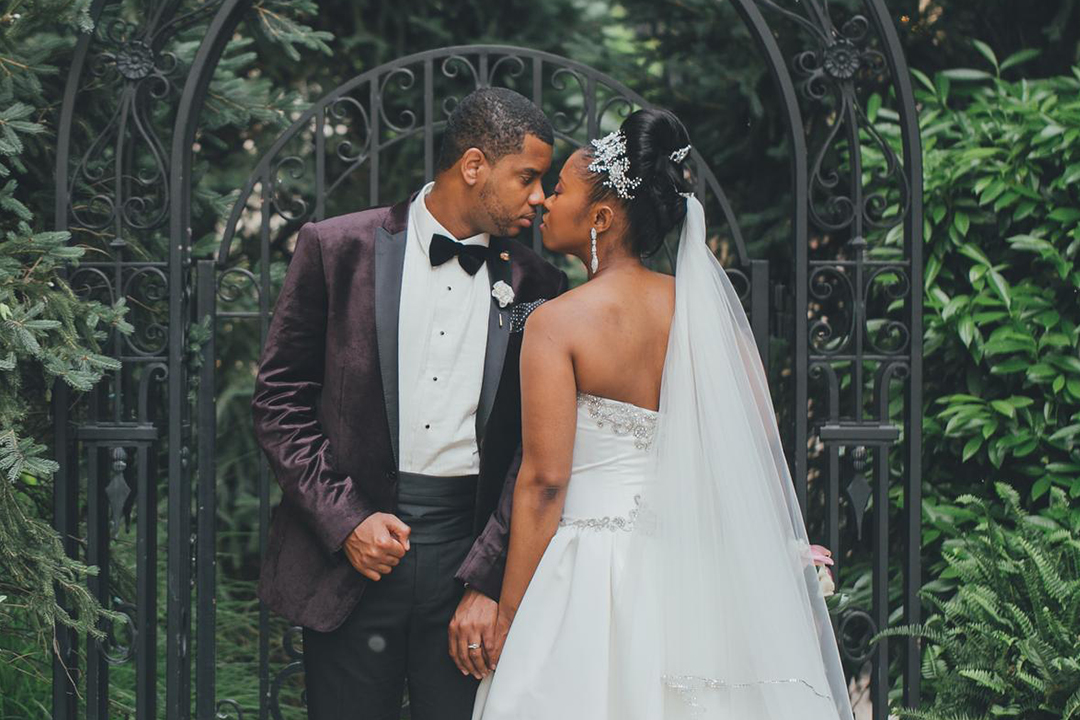
When it comes time to pull your wedding day look together, there are plenty of different pieces to coordinate. From your dress and your shoes to your accessories and your undergarments, every item is carefully selected to create your bridal aesthetic—and that includes your hair and veil situation.
If you’re trying to narrow down your search for wedding hairstyles with a veil, we’re breaking it all down to help you find the best hair/veil combo for your walk down the aisle. From the history of veils to how to find the right one, here’s everything you need to know about rocking this traditional bridal hair accessory:
The History of Wedding Veils
Whether you opt to wear a veil or not, you might not realize how much history is hidden in such a simple accessory. It turns out that a wedding veil is one of the oldest additions to a bridal ensemble, and it holds special meaning for ceremonies of the past.
When did brides first start wearing wedding veils?
The veil is “the oldest part of the bridal ensemble,” Wedding Historian Susan Waggoner told Brides.com. The accessory dates back to ancient times when people “wrapped brides from head to toe to represent the delivery of a modest and untouched maiden.”
In addition to the bride being wrapped up like a gift, the cover also helped hide her away from evil spirits who might try to thwart her happiness. In fact, this is how the tradition of bridesmaids became a wedding staple too. The bride’s maids would dress up in white to match the bride and confuse any evil spirits who might want to ruin the special day. Between the bridesmaids and the veil, the bride was pretty well covered on the spirit protection front—literally.

Why did people start wearing wedding veils?
Evil spirits aside, the more practical reason for veils stemmed from the days of arranged marriages. Traditionally, grooms wouldn’t see their brides’ faces until the actual wedding ceremony (and sometimes not even until after consummation). This was a way for the families to ensure that the union happened and to avoid the risk of the bride or groom running away if they didn’t like the look of their future spouse.
The accessory became a fashion staple, however, in 1840. Queen Victoria wore a white dress with a cascading veil in her wedding to Prince Albert, making her the first modern monarch to say “I do” in a veil, thus transforming the accessory into a bridal staple.
What do wedding veils symbolize?
While it might just seem like a simple piece of fabric, veils mean a lot of different things to a lot of different people and cultures. For some people, the veil represents purity and modesty, but that’s just the tip of the historical and religious symbolism. In Christian weddings, the veil represents the garment that was removed when Christ died, and, per Catholic tradition, when the veil is removed, it represents that the bride has given herself over to the groom.
In an orthodox Jewish nuptial ceremony, the groom covers the bride’s face with a veil just before the wedding ceremony. Once the formal proceedings are over, he then lifts the veil. This ceremony, called the Bedeken, dates back to, and is representative of, the meeting between Isaac and Rebekah, during which Rebekah concealed her face with a veil.
Many Indian wedding ceremonies also include the use of a bridal veil. While the traditional, red Hindi veil—called a ghoonghat—has become outdated due to its sexist and archaic nature, many Indian brides utilize veils in their nuptial ceremonies. The most popular option is a double dupatta style, which utilizes one heavy, embroidered veil for the shoulder and a second, lighter one that covers the head.
Regardless of religion or origin, many brides simply choose to wear a veil because it feels bridal, and that in and of itself is symbolic.
Should I wear a veil to my wedding?
Nowadays, the wedding veil is mostly used as an accessory that makes a bridal look feel complete for most to-be-weds. Ultimately, it’s up to you and your partner to decide what feels right for your wedding day. What matters is that the choice should feel like a reflection of you, your relationship, and your celebration. Whether that means with or without a veil, you’ll feel the magic on your special day.
How to Choose Your Wedding Hairstyle
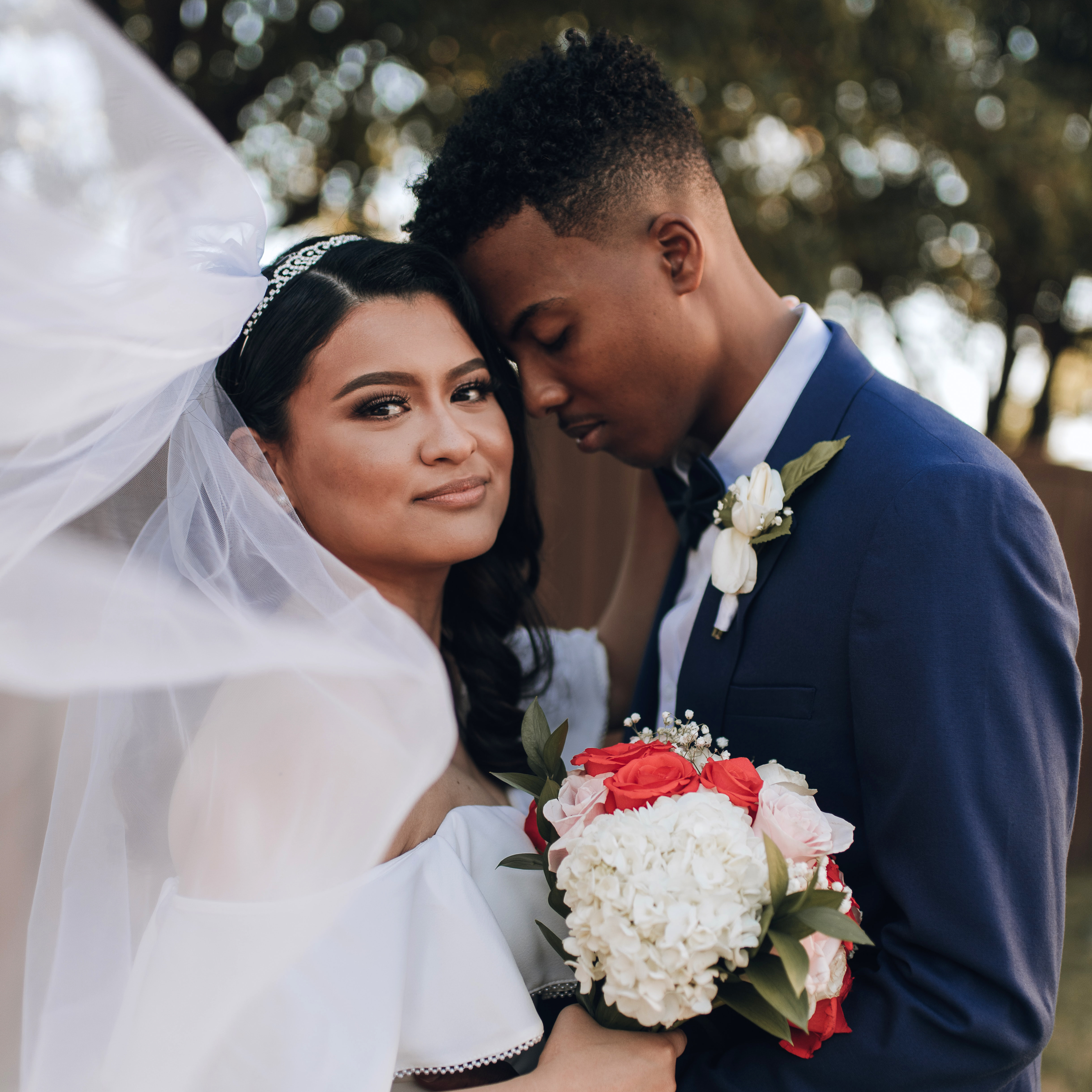
While choosing whether or not to wear a veil during your wedding ceremony is a big deal, often the first step in the process is considering your hairstyle. Your wedding hair will help determine the type of veil that would work best. Unless you’re using an heirloom veil (in which case you’ll want to choose the hairstyle based on the veil), narrow down the bridal hairstyles you want for your wedding—and then choose the best veil to pair with that hairdo. Here’s what to consider when narrowing down your style choices:
Consider your wedding theme
The very first step to choosing the best wedding hairstyle? Consider your theme, venue, formality, and wedding colors. Different events call for different styles; a casual beach wedding would warrant a different veil than an elegant castle wedding.
It's also important to consider the elements. “Anything with an outdoor environment greatly affects how the hair should be styled for longevity,” Senior Stylist at Radio London, Heather King-Labeur, previously told Zola.
Need inspiration? Check out real wedding photos from events similar to what you're planning to get a sense of what hairstyles work with the setting—especially if you’re having an outdoor wedding where heat and humidity are factors.
Consider your dress
Next, King-Labeur suggests considering your wedding dress and accessories to ensure that your hairstyle complements your ensemble, not detracts from it. A good rule of thumb: Styles with higher necklines look elegant with updos and chic, shorter styles, whereas strapless and décolleté-showing styles are great for wearing your hair down. Additionally, if your dress/accessories are more elaborate, you might prefer opting for a less ornate ‘do.
Consider your hair length
Naturally, your hair length will play a factor in the styles you choose; certain veils will work better with long hair over short hair (and vice versa). But if you have a vision that doesn’t work with your current hair length, get creative! Options like weaves, wigs, and extensions can give you longer-looking locks, and some artfully placed pins or barrettes can make your hair look shorter if you’re after a cropped style. (Not sure how to pull this off? Ask your hairstylist.)
Hairstyles With Veil Considering Your Hair Type
It's also important to consider your hair type to determine the best look that will hold all night long. There are multiple ways to identify your hair, but Kristina Maccaro, a New Jersey-based stylist and owner of Love Lane Salon, previously told Zola that the four most commonly referenced hair types “come from the Andre Walker Hair Typing System"—straight, wavy, curly, four is kinky. Here are a few of our favorite hairstyle ideas for each type of hair:
Type 1: Straight
Type one is straight hair that is anywhere from fine and fragile to coarse and thin. One of the main factors here is that it’s curl resistant (so it doesn’t curl naturally). Half-up half-down with wand curls (use lots of hairspray).
- A beautiful braid—whether it’s a fishtail braid or French braid.
- A sleek, edgy bob that’s simple and elegant.
- A classic loose bun, low bun, or chignon with some soft, fluffy tendrils.
Type 2: Wavy
Type two is identified as wavy hair that’s fine and thin to coarse and frizzy. If your hair has a little body to it, it’s probably wavy.
- A swirl pin-up style for a vintage look.
- Wand enhanced waves to elevate your natural style.
- A sleek, wavy ponytail to keep things cool and stylish.
- A beautiful, bouncy blowout with a side or center part.
Type 3: Curly
Type three is considered curly hair, which could be anything from loose curls to corkscrew curls. If you’ve got curls that are more defined than casual waves, you’re probably rocking type three.
- Go all-natural with long, free-flowing loose curls.
- An on-trend, one-shoulder scooped braid.
- An intricate, double braided halo bun.
- A curly bun that showcases your texture.
Type 4: Kinky
Type four hair is considered kinky and boasts tight coils to Z-angled coils. Some of our favorite bridal styles involve natural hair and tight coils.
- A curly afro updo is an elegant and sophisticated choice.
- A classy, high bun.
- Rock some free fall coils, highlighted with a dazzling bridal headpiece.
- Dress up your dreadlocks by tying them into Bantu knots overnight and unraveling them on the day of your wedding.
Types of Veils
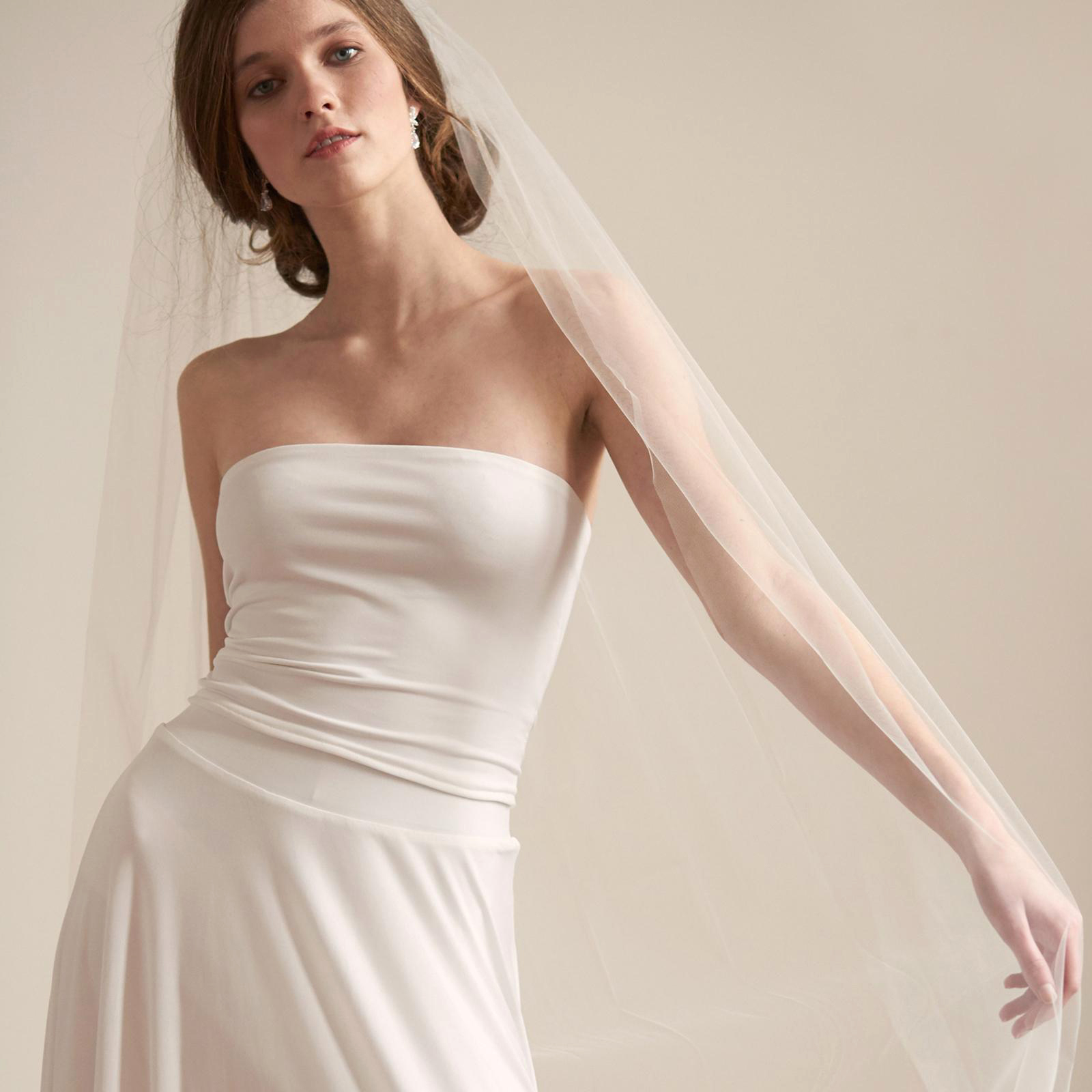
There are as many types of veils as there are types of weddings. From short and spunky numbers to long, luxurious versions, we’re breaking down the different types of veils for you to consider on your big day—plus providing tips for narrowing down your options:
Birdcage (Bandeau Veil)
A short and playful veil—usually made of net, lace, or tulle—the birdcage veil typically covers the eyes but skims the nose or lands at the jawline. Length: 4-9 inches Best for: Vintage-themed weddings; lace dresses; bold lips; retro accessories
Blusher
Blushers are a thin piece of tulle that covers the face and ends at the shoulders. They’re usually paired with another veil and are pulled before the couple’s first kiss. Length: 30 inches Best for: traditional ceremonies or drama-loving brides
Cathedral-Length Veil (Royal Veil)
Cathedral veils are the longest style available. They’re so long that they touch the floor and extend beyond a wedding gown’s train. Also referred to as a royal veil, cathedral veils are ideal for grand entrances and dramatic exits. Length: 100-120 inches Best for: formal or glamorous settings; ideal for long aisles and/or grand entrances and exits
Chapel-Length Veil
The chapel-length veil is single-tier; it's typically made of tulle and rests on the floor a few inches beyond the gown. Length: 90 inches Best for: traditional weddings and pretty much any dress and setting; extremely versatile
Elbow-Length Veil
The elbow-length veil drapes over the shoulders and hits right around the elbow area. Length: 25-32 inches Best for: ball gowns and minimalistic gowns; anyone who wants to frame your face or opt for a simpler veil look.
Fingertip Veil
The fingertip veil is mid-length veil that, as the name implies, reaches to your fingertips. Length: 38-40 inches Best for: semi-formal weddings; anyone who wants lots of movement in their veil.
How do you pick your veil?
Once you’ve selected your dress and a hairstyle idea or two, the next step is to select your veil. Pay attention to the details on your gown/outfit, consider your venue and the statement you want to make, and picture yourself walking down the aisle. Even if you don’t think you want to wear a veil, it’s a good idea to try a few on just to get an idea of how they look and to perhaps inspire you with some exciting veil alternatives.
4 Wedding Veil Alternatives
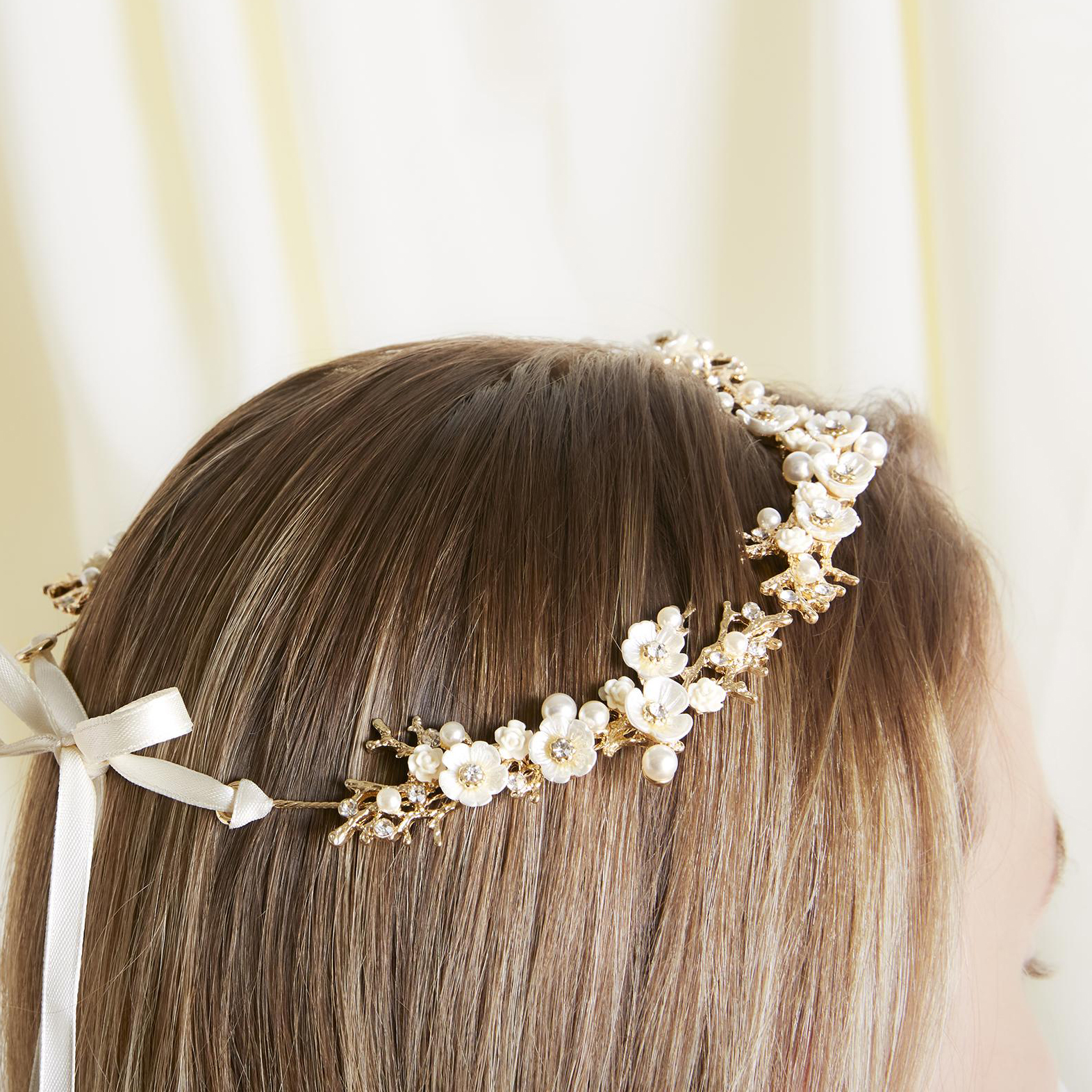
While some brides can’t imagine their wedding ensemble without a veil, others aren’t fans of the look. If you don’t want to wear a veil, there are plenty of other options to consider to dress up your ceremony style.
Headbands
From jeweled or beaded options to braided pieces that look like your own hair, headbands are a chic and unique way to elevate your wedding day hairstyle sans veil. If there’s a headband that you love, you can even add it in addition to a veil if you want the best of both worlds.
Crowns/Tiaras
If you want to feel like a queen on your special day, there's no other hairpiece that captures the look quite like a crown or tiara. Whether you’re after something subtly sparkling or something elaborate and ornate, there are plenty of options in a variety of colors and metals to choose from. A few options we really love are crystal/rock crowns for modern weddings, and a flower crown or greenery crowns for boho or outdoor celebrations.
Flowers/Greenery
Why not opt for a more natural look for your wedding, especially if you’re utilizing a lot of floral elements in your celebration? You can easily tuck flowers behind your ear, into your hairstyle, or on your wedding updo to create an earthy, romantic feel.
No Veil
Who says you need to wear a veil on your wedding day? There’s no rule that says the only way you can look like a bride is by wearing tulle on your head. If you don’t want to include a veil in your wedding day look and you’re not a fan of the alternatives, don’t feel obligated to include this wedding accessory. The point of the day is to look and feel like yourself, and if that means walking down the aisle without a veil or headpiece, then do it!
Zola: The Answer to All Your Bridal Accessory Needs
Need help choosing the perfect bridal accessories? With a selection for every style and every budget, at Zola’s wedding shop, we have everything you need to craft the perfect wedding day look—whether that's a vintage-looking birdcage veil atop a pinup bun; a long cathedral veil paired with your hair lightly curled; or any look in between.
Up next for you
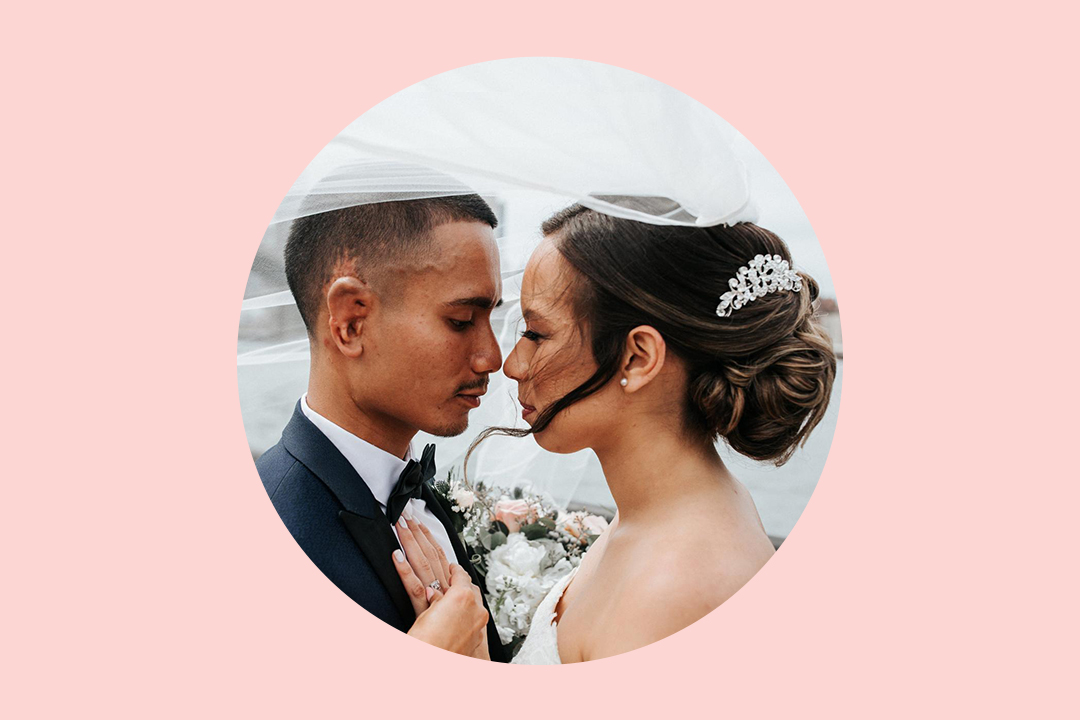
20 Bridal Hair Accessories That You’ll Love
List
From consulting with your hairstylist to honing in on your style, we have tips on finding bridal hair accessories that you’ll adore.

Train or No Train? The Pros and Cons of Wedding Dress Trains
Advice
To have or not to have a wedding dress train? That is the question we will help you answer today.
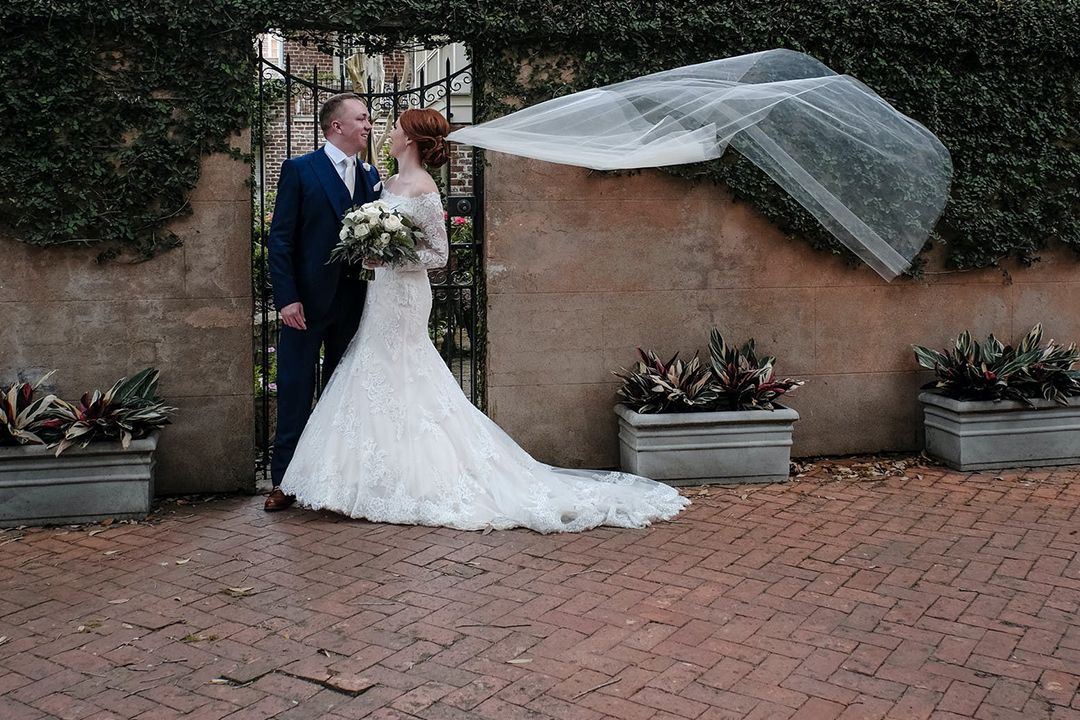
Veil or No Veil: The Pros and Cons of Each
Advice
While wearing a veil on your wedding day isn’t required, it’s definitely something to give some thought to. Deciding whether or not to wear one? We’ve compiled pros and cons for each side—veil or no veil.
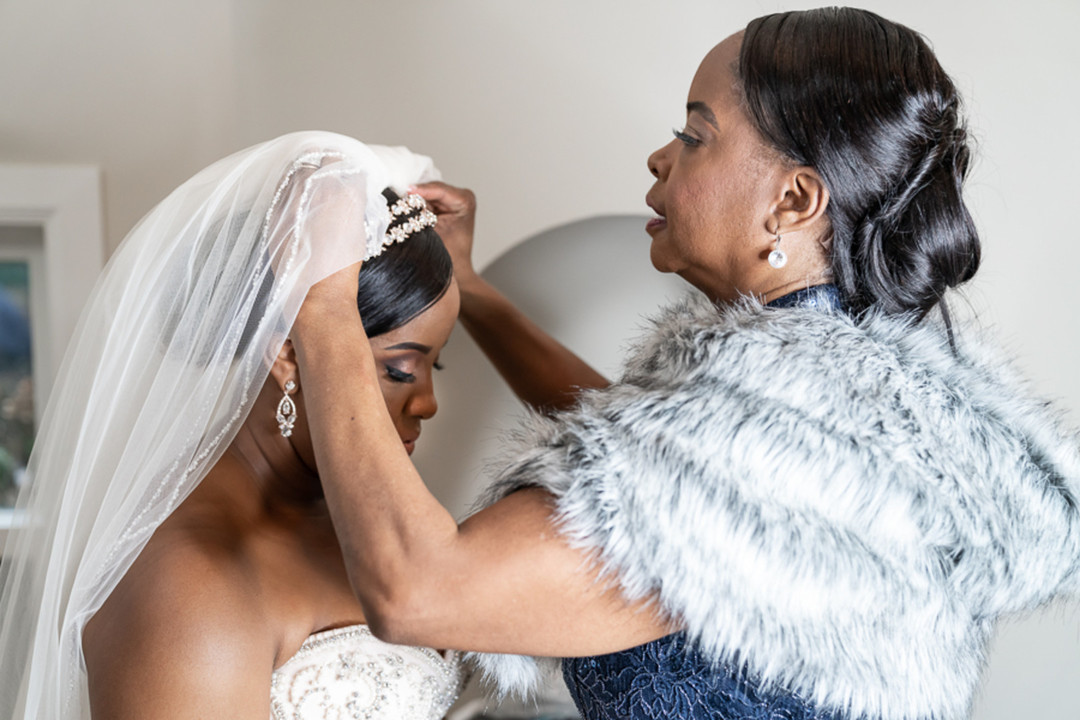
9 Wedding Accessories to Complete Your Bridal Look
Inspiration
You got the dress now top it all off with wedding accessories that will make your bridal look really stand out. Here are nine wedding accessories every bride needs.
Featured
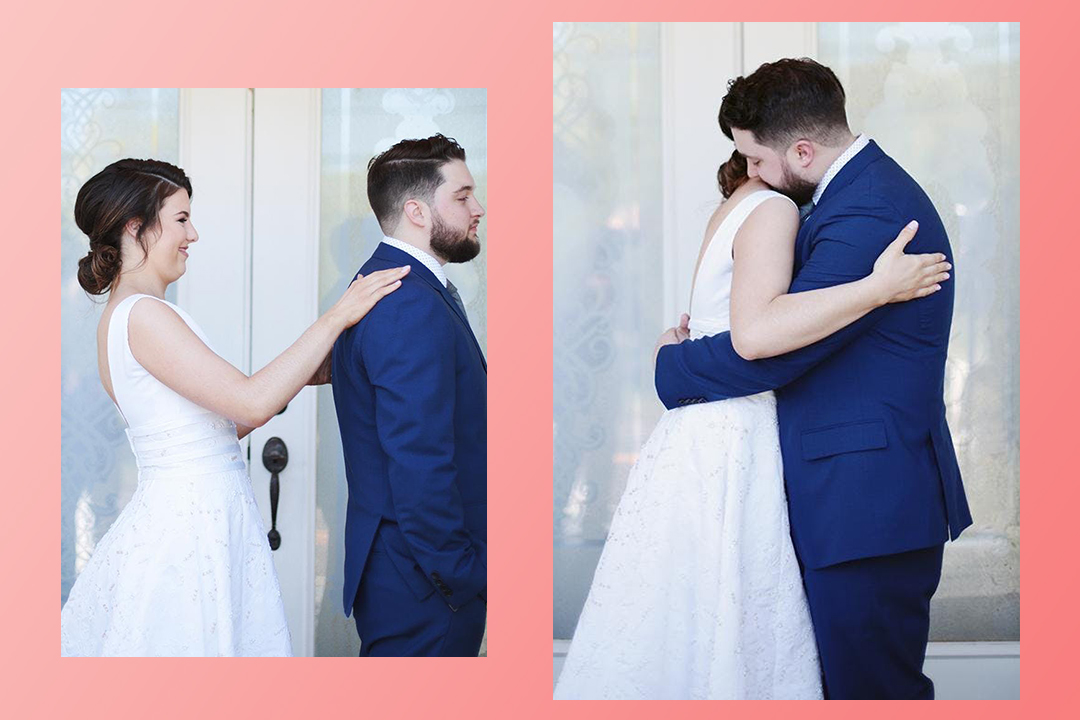
50+ Ideas You Need to Include On Your Wedding Photo Shot List
List
Your wedding photo shot list is basically a checklist for your wedding photographer. Don't forget any of those special moments with our complete guide to your wedding photo list.
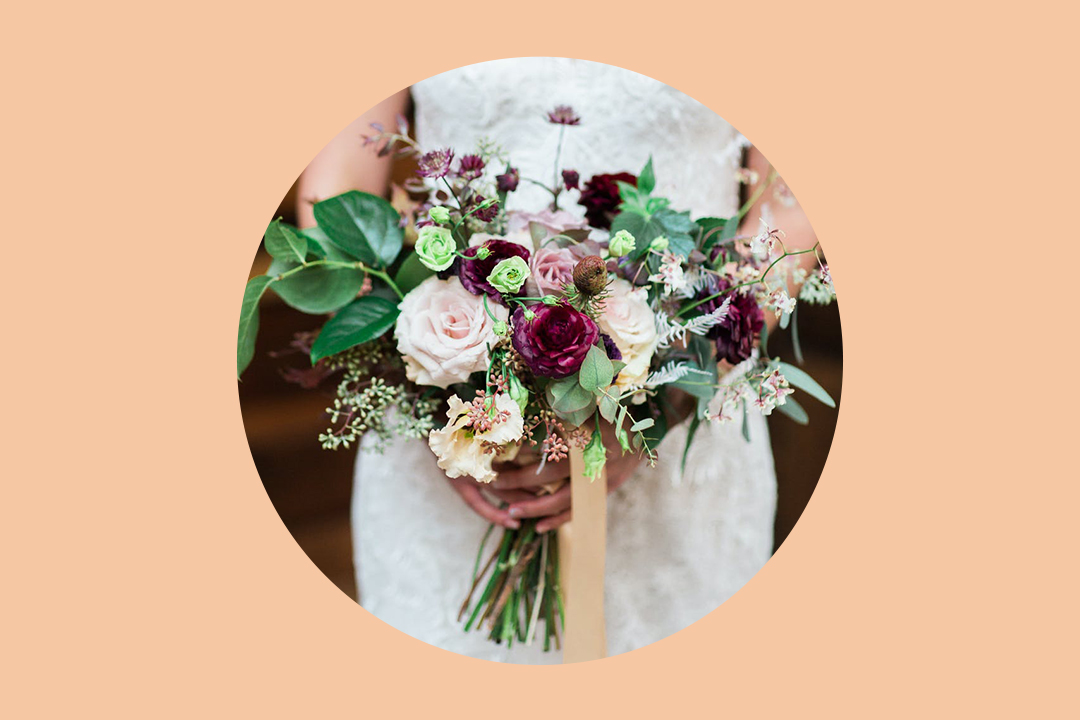
The Complete Guide of Wedding Flowers by Season
Wedding Style
Incorporating seasonal flowers into your wedding day gets you the best quality blooms for a lower price tag. This guide can help you save big on your floral budget, no matter what time of year you plan to tie the knot.
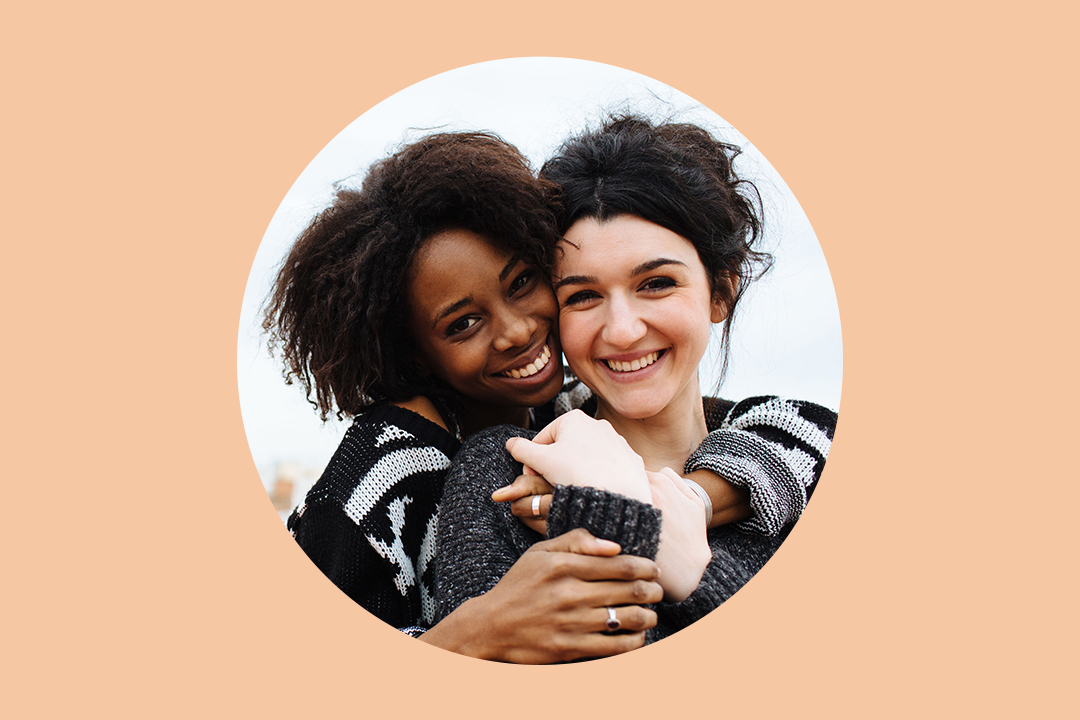
How to Take Authentic-Looking Engagement Photos
How-To
Engagement photos tend to all look the same. Stand out and take photos that feel unique to you with our guide to taking authentic engagement photos.
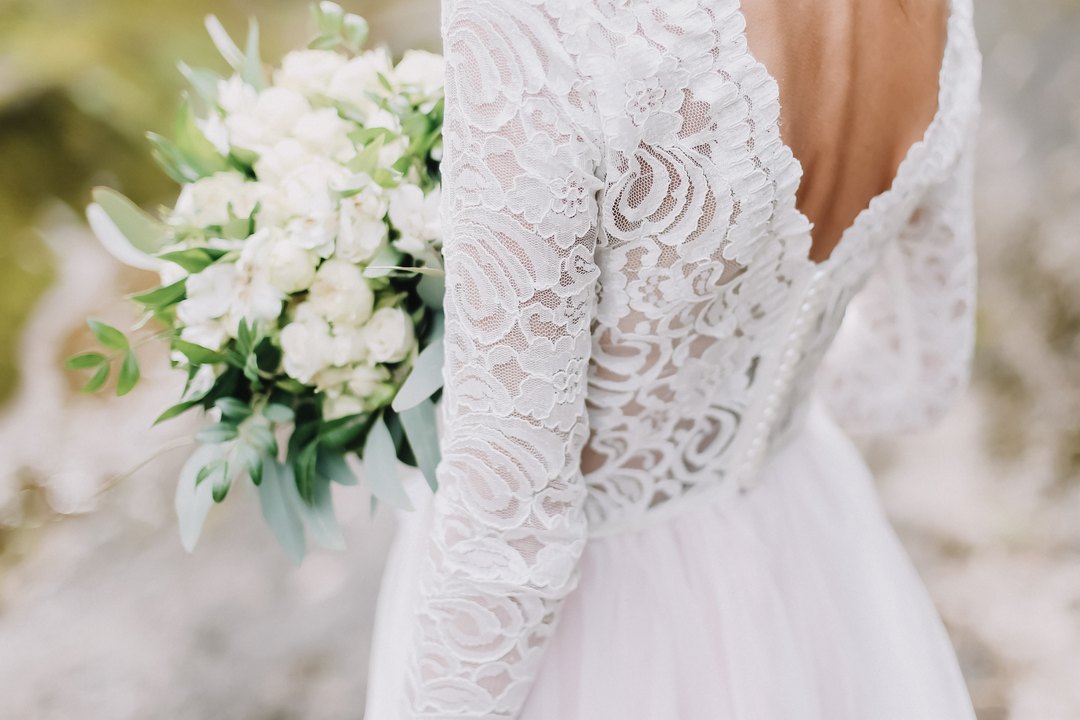
Classic Wedding Dresses For The Traditional Bride
List
Weddings are steeped in love, family, friends, and tradition. Take a look at these gorgeous, traditional wedding dresses to find your perfect fit with Zola.
- Expert advice/
- Fashion & beauty/
- Shoes & accessories/
- Wedding Veil Meaning & Style Guide
Find even more wedding ideas, inspo, tips, and tricks
We’ve got wedding planning advice on everything from save the dates to wedding cakes.
